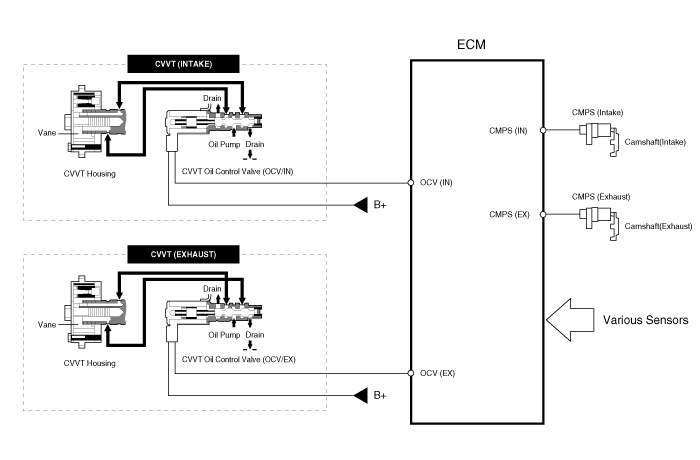 Kia Forte: CVVT (Continuously Variable Valve Timing) System Description
Kia Forte: CVVT (Continuously Variable Valve Timing) System Description
Second generation YD (2014-2018) / Kia Forte TD 2014-2018 Service Manual / Emission Control System / Exhaust Emission Control System / CVVT (Continuously Variable Valve Timing) System Description
Continuous Variable Valve Timing (CVVT) system advances or retards the
valve timing of the intake and exhaust valve in accordance with the ECM control
signal which is calculated by the engine speed and load.
By controlling CVVT, the valve over-lap or under-lap occurs, which makes
better fuel economy and reduces exhaust gases (NOx, HC) and improves engine
performance through reduction of pumping loss, internal EGR effect, improvement
of combustion stability, improvement of volumetric efficiency, and increase
of expansion work.
This system consist of
| - |
the CVVT Oil Control Valve (OCV) which rgulates engine oil to
and from the cam phaser in accordance with the ECM PWM (Pulse With Modulation)
control signal,
|
| - |
and the Cam Phaser which varies the cam phase by using the hydraulic
force of the engine oil.
|
The engine oil getting out of the CVVT oil control valve varies the cam
phase in the direction (Intake Advance/Exhaust Retard) or opposite direction
(Intake Retard/Exhaust Advance) of the engine rotation by rotating the rotor
connected with the camshaft inside the cam phaser.

 Catalytic Converter Description
Catalytic Converter Description
The catalytic converter of the gasoline engine is a three way catalyst.
It oxidizes carbon monoxide and hydrocarbons (HC), and separates oxygen from
the oxides of nitrogen (NOx).
[SULEV]
...
 CVVT (Continuously Variable Valve Timing) System Operation Principle
CVVT (Continuously Variable Valve Timing) System Operation Principle
The CVVT has the mechanism rotating the rotor vane with hydraulic force
generated by the engine oil supplied to the advance or retard chamber in accordance
with the CVVT oil control valve con ...
See also:
SS-B Solenoid Valve(ON/OFF) Inspection
1.
Turn ignition switch OFF.
2.
Disconnect the Solenoid valve connector.
3.
Measure resistance between sensor ...
Interior overview
1. Driver position memory system button
2. Inside door handle
3. Outside rearview mirror folding
4. Outside rearview mirror control
5. Central door lock switch
6. Power window lock switch
7. ...
Installation
1.
Install the horn and connect the horn connector.
2.
Reassemble the front bumper cover.
...
Copyright ® www.kifomanual.com 2014-2025
